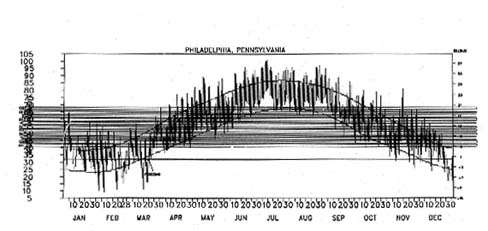Climate
The natural environment is woven on chance and complexity. A hundred different factors from the Character and aspect affect the condition of a given site. How much sun does it receive? How much wind? Which direction does it face? What kind of soil does it have? What type of grade and slope? And so on. In the city, the situation is different. Space is structured by lines not found in nature: perpendicular, rectilinear, engineered lines. The materials are uniformly harsh, stern, and obdurate. For humans, this can make for uncomfortable areas to live. The over-concentration of any number of influences makes city living unpleasant, unhealthy, or even hazardous. The air may be particle-heavy due to lack of circulation; the street, constantly shaded, or too sunny; cold; or filled with water. The trick, then, is to make unnatural city sites more in harmony to the way nature works.

The Appalachian Mountains to the west and the Atlantic Ocean to the east has a moderating effect on climate in the Philadelphia region. Periods of very high or very low temperature seldom last for more than three or four days. Temperatures below zero or above 100 degrees are a rarity. On occasion, the area becomes engulfed with maritime air during the summer months, and high humidity adds to the discomfort of seasonably warm temperatures.
Precipitation is fairly evenly distributed throughout the year with maximum amounts during the late summer months. Much of the summer rainfall is from local thunderstorms and amounts in very different areas of the city. This is due, in part, to the higher elevations to the west and north. Snowfall amounts are often considerably larger in the northern suburbs than in the central or southern parts of the city. In many cases, the precipitation will change from snow to rain within the city. Single storms of ten or more inches occur about every five years.
The prevailing wind direction for the summer months is from the southwest, while northerly winds dominate during the winter. The annual prevailing direction is from the west-southwest. Destructive velocities are comparatively rare and occur mostly as gusts in summer thunderstorms. High winds occurring in the winter months, as a rule, come with the advance of cold air after the passage of a deep low pressure system. Only rarely have hurricanes in the vicinity caused widespread damage, primarily because of flooding. Flood stages in the Schuykill River normally occur about twice a year. Flood stages seldom last over twelve hours and usually occur after excessive thunderstorms.

|

|
Web Links
- WPLP
- Urban Nature
- Urban Nature -Water
- Urban Nature - Geology
- Urban Nature - Topography
- Urban Nature - Vegetation
- International Weather
- NOAA Network Information Center
- NOAA Environmental Information Services
- Sites of Interest
- DESCRIBING THE PLACE